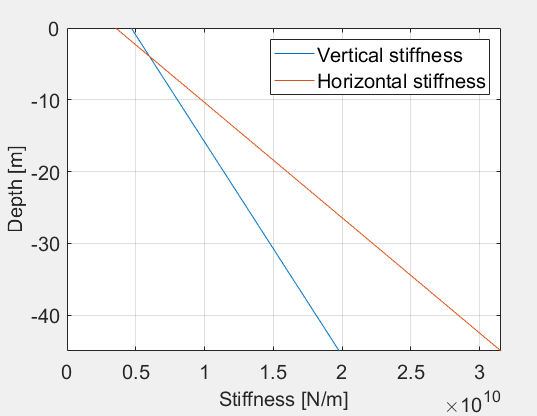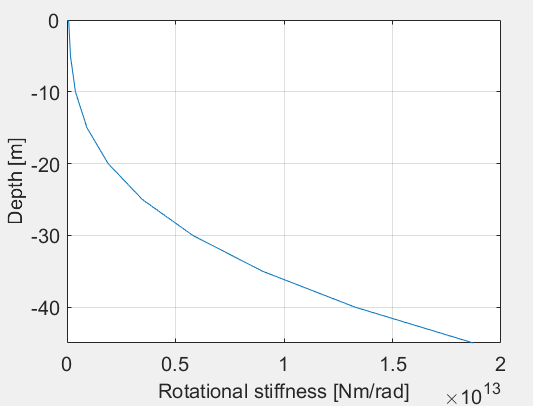IEA 15-MW
This document details how different parts of the IEA 15-MW reference wind turbine are implemented in Ashes.
1 Blade
The IEA 15-MW blade is based on the data published on GitHub in this repository:
https://github.com/IEAWindTask37/IEA-15-240-RWT
(last accessed February 2021)
1.1 Blade shape
For the
Blade shape file
, we used the data from the Aerodyn input file, which has the same format as Ashes. The file can be found at
this link
.
Two modifications have been made to the Aerodyn input file:
1) The aerodyn input file uses 50 different airfoils. In order to simplify the model, we use the airfoil distribution given in the spreadsheet found at
this link
, in the
Blade geometry
tab.
2) The column
BlSwpAC
(in-plane prebending) in the Aerodyn file is equal to zero, which means that for each
Blade aerodynamical station
, the pitch axis goes through the
Aerodynamical reference point
of the airfoil. Therefore, for a blade aerodynamical station
$$i$$
, the value of the BlSwpAC column of the Ashes file is calculated as follows:
$$\text{BlSwpAC}_\text{Ashes}(i) = \text{AR}_\text{AeroDyn}(i)\cdot\text{ChordLength}(i)$$
where
$$\text{AR}$$
is the location of the
Aerodynamical reference point
.
Note:
when computing
BlSwpAC
, we have used the Aerodynamic reference points of the model with 50 airfoils (rather than that of the model with 8 airfoils) since those are the airfoils used to create the AeroDyn input file
1.2 Blade structure
For the
Blade structure file
, we use the Hawc2 input file provided in
this link
. This file corresponds to the fully flexible blade with torsion and without the fully populated stiffness matrix. The equivalence between the Ashes input and the Hawc2 input is given in the
Hawc2 to Ashes
document.
Note
: on the structural file for the IEA 15-MW blade, the column for the torsional stiffness has been replaced by the polar moment of inertia. As explained in the Hawc2 User manual, these will be the same for a circular cross section, which is not the case for blade structural stations in general. We believe that this is a typo in the.Hawc2 file and that the value written in the file is actually the torsional stiffness. We have therefore used that value in our definition of the
Blade structure file
.
2 Airfoil data
The data for the
Airfoil geometry file
and the
Airfoil polar file
for each airfoil is taken from the spreadsheet available at
this link
on the tabs corresponding to each airfoil.
3 Controller
For the IEA 15-MW reference wind turbine, the ROSCO controller is provided with Ashes. The source code for the controller is freely available on GitHub in
this repository
. A 64 bit compiled for Ashes is provided in the
DLL Controller
folder.
Two input files are required to run the ROSCO controller for the IEA 15-MW wind turbine:
- the file Cp_Ct_Cq.IEA15MW.txt , which contains tables with Cp, Ct and Cq for different wind speeds and blade pitch angles
- the file IEA15MW.IN , which contains information about the wind turbine and the path to the Cp_Ct_Cq.IEA15MW.txt file
We have re-generated the Cp, CT and Cq curves with Ashes so that the ROSCO controller produces a behaviour closer to what it was designed for, but we have not modified the IEA15MW.IN file. The original files have the text
_original
appended to their names, and can also be downloaded from the repository.
4 Tower
In
Gaertner et al. (2020)
, the tubular tower is defined with cone elements, which have different top and bottom diameters and a constant thickness. In Ashes, elements must have constant diameters, therefore the elements have a diameter equal to the average between the top and bottom diameters defined by
Gaertner et al. (2020)
. This ensures that the mass of the tubular tower in Ashes is virtually the same as in the specification document, but the top diameter is slightly different (6.536 m in Ashes vs 6.5 m in the specification document). The bottom element of the tower has a constant diameter of 10 m both in Ashes and in the specification document.
With the specified
Young's modulus
$$E = 2.00\cdot10^{11}\text{ Pa}$$
and
Shear modulus
$$G = 7.93\cdot10^{10}\text{ Pa}$$
we obtain the
Poisson ratio
through the equation
$$\nu=\frac{E}{2G}-1=0.261$$
5 Monopile
The monopile has a constant diameter of 10 m and a varyng thickness between 41 and 55 mm, as specified in
Gaertner et al. (2020)
.
The pile is embedded 45 m below the sea level (75 m below the water level).
The soil is modelled with linear springs as specified in Appendix B2 of
Gaertner et al. (2020)
.
The table below shows the values of stiffnesses used in the model:
|
Depth below sea level
$$h\text{ [m]}$$
|
Vertical stiffness
$$k_z\text{ [N}\cdot\text{m}^{-1}\text{]}$$
|
Horizontal stiffness
$$k_x\text{ [N}\cdot\text{m}^{-1}\text{]}$$
|
Rotational stiffness
$$k_\Psi\text{ [Nm}\cdot\text{rad}^{-1}\text{]}$$
|
Torsional stiffnes
$$k_T\text{ [Nm}\cdot\text{rad}^{-1}\text{]}$$
|
| 0 | 4.6667E+9 | 3.5368E+9 | 7.7778E+10 | 9.3333E+10 |
| -5 | 6.3467E+9 | 6.6493E+9 | 1.5867E+11 | 9.3333E+10 |
| -10 | 8.0267E+9 | 9.7617E+9 | 3.8889E+11 | 9.3333E+10 |
| -15 | 9.7067E+9 | 1.2874E+10 | 9.1778E+11 | 9.3333E+10 |
| -20 | 1.1387E+10 | 1.5987E+10 | 1.8947E+12 | 9.3333E+10 |
| -25 | 1.3067E+10 | 1.9099E+10 | 3.4689E+12 | 9.3333E+10 |
| -30 | 1.4747E+10 | 2.2211E+10 | 5.7898E+12 | 9.3333E+10 |
| -35 | 1.6427E+10 | 2.5324E+10 | 9.0067E+12 | 9.3333E+10 |
| -40 | 1.8107E+10 | 2.8436E+10 | 1.1369E+13 | 9.3333E+10 |
| -45 | 1.9787E+10 | 3.1549E+10 | 1.8726E+13 | 9.3333E+10 |
The vertical and horizontal stiffness variations with depth below the sea level is plotted below:

The rotational stiffness variation with depth below the sea level is plotted below:

6 Verification of the model
We run tests nightly to ensure that the results in Ashes match the specification document. These tests can be found in the
IEA 15-MW Benchmarks
documents.